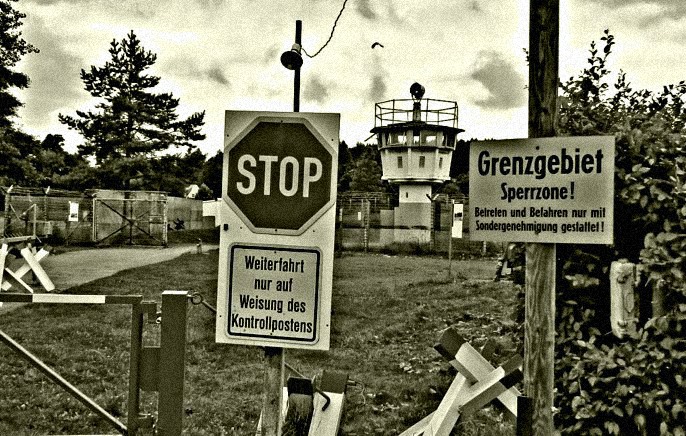Standing on a grassy bank opposite an innocent looking and soggy line of forested trees on the other side of a stream was not how we imagined seeing a view of 20th century Europe. But truthfully, we were in Germany, whilst opposite was both Poland and the Czech Republic.
More poignantly we were in three former Soviet Bloc countries, now all members of the European Union and since the Shengen Area Agreement in 2007, without borders and viscously policed state lines.

After the Yalta and Potsdam agreements carved up post war Europe between the allies – Churchill, Roosevelt and Stalin – Germany lost 25% of its land mass, comprising some 12 million people, to the lands of Poland and Czechoslovakia, but ultimately to Russia.
Poland referred to its new lands as ‘recovered territories’ as they had indeed been Polish before being appropriated by the Prussian Empire. It regained Gdańsk (Danzig), Silesia, Pomerania and lands east of the natural border created by the Oder and Neisse rivers. Poland lost parts of Belarus, Ukraine and Lithuania to Russia.


Germans in the annexed territories fled, were forcibly removed or were killed. Heroic stories of Polish and Czech people still abound, telling of those who saved German families by pretending they were their own.
German civilians were horrifically ‘punished’ by the retreating Red Army as it was encouraged by its leaders to maraud its way home. Mass exodus was organised as people fled or were forced into the German Democratic Republic, the new East Germany.

Today the borderland between all three countries is open country. Where an ugly gash had been cut through the dark forest and filled with barbed wire to prevent Polish and Czechs from meeting, it is now a scenic cycle path.
Germany is in part across the water but is accessible in both countries over forest foot paths and traffic and railway bridges. Market stalls sell cut price cigarettes, local produce and cheap Chinese clothing at all three borders. Germans whizz about in flashy cars, Poles and Czech tend to drive older ones.
In one day, we woke up and breakfasted in Germany, cycled into and about Poland and bought a porky lunch to munch in the Czech Republic before making it back to the rather grand Marktplatz in Zittau, for the Kaffee und Kuchen hour at 4pm.
This might sound like an epic tour, but we had only cycled ten miles by the time we arrived back into Germany.

A notable incident – at the Czech border an elderly German couple had been pulled over and fined €200 for not having the headlights on their car on and dipped. We commiserated on their being only two meters into the country.
The Czech police officers smiled and shrugged… and carried out the paperwork and punched numbers into a Visa card machine.
It was incredible, and sobering, to think of the dream of the late 20th century that dared believe a peaceful solution could be found to bring not just these three countries, but all other countries of Europe together in free trade and free movement.
The senselessness of Brexit and the uncertainty of our own situation at home was magnified simply by standing in the rain and watching it fall, indiscriminately, on Poland, the Czech Republic and that great anchor of modern Europe, a reunified Germany.

















